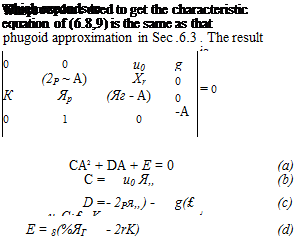ROLLING MODE
It was observed in Sec. 6.7 that the rolling convergence is a motion of almost a single degree of freedom, rotation about the x-axis. This suggests that it can be approximated with the equation obtained from (4.9,19) by putting v = r = 0, and considering only the second row, that is,
p = $„P (6-8,7)
which gives the approximate eigenvalue
XR = %P = LpH’x + I’zxNp (6.8,8)
The result obtained from (6.8,8) for the B747 example is AR = —0.434, 23% smaller than the true value -0.562. This approximation is quite rough.
An alternative approximation has been given by McRuer et al. (1973). This approximation leads to a second-order system, the two roots of which are approximations to the roll and spiral modes. In some cases the roots may be complex, corresponding to a “lateral phugoid”—a long-period lateral oscillation. The approximation corresponds to the physical assumption that the side-force due to gravity produces the same yaw rate r that would exist with /3 = 0. Additionally Yp and Yr are neglected. With no approximation to the rolling and yawing moment equations the system that results for horizontal flight is
0 = ~u0r + g(f) (a)
p = !£vv + !£pp + £rr (b)
r = Jfvv + Ярр + Ягг (c) (6.8,9)
 |
|
Ф = P (d)
The result of applying (6.8,11) to the B747 example is
A, = -0.00734 and A* = -0.597
These are within about 1 % and 6% of the true values, respectively, so this is seen to be a good approximation for both modes, certainly much better than (6.8,7) for the rolling mode.











